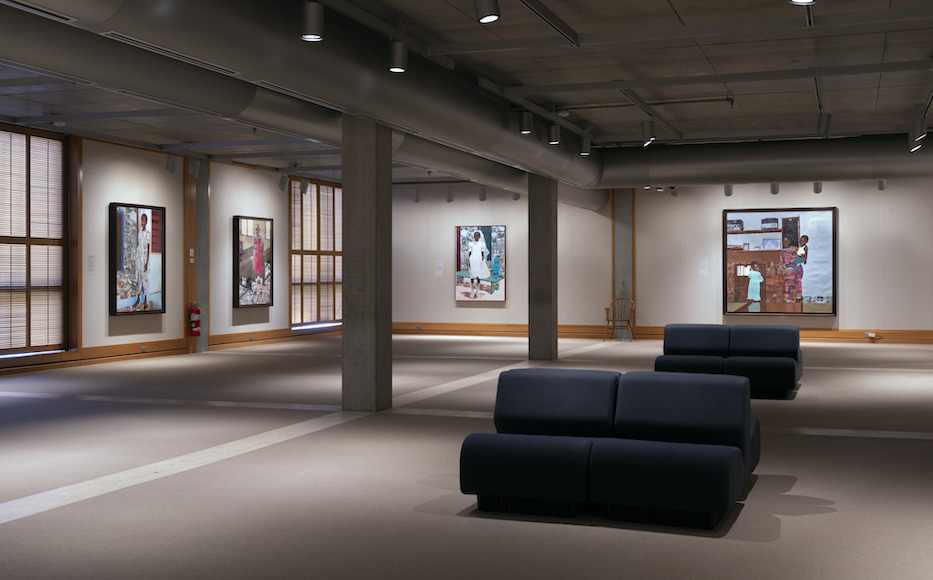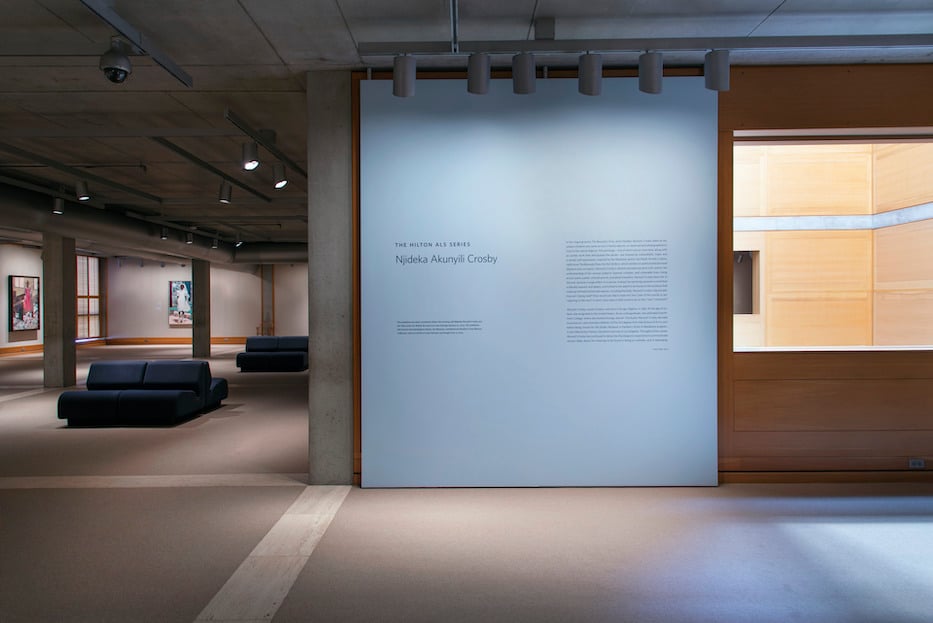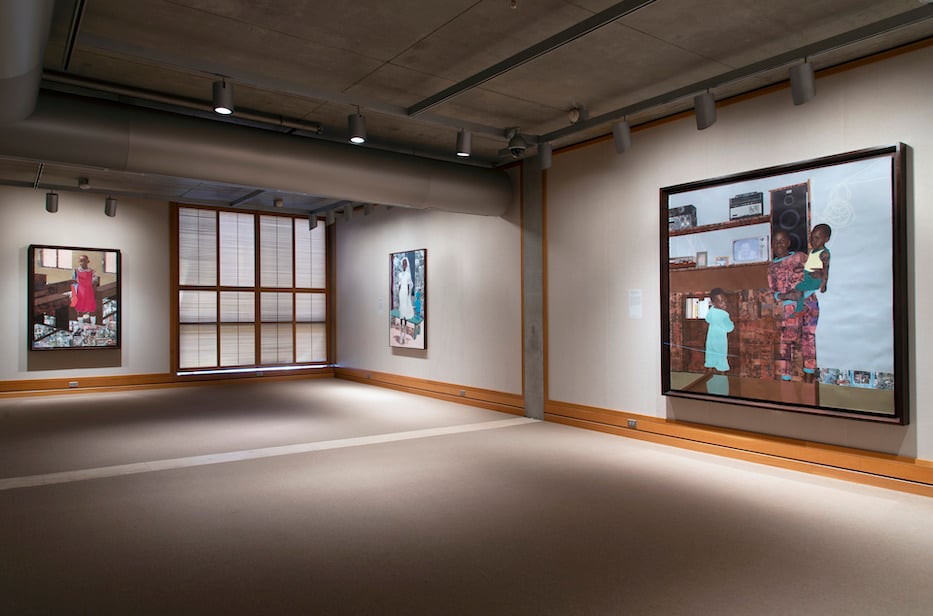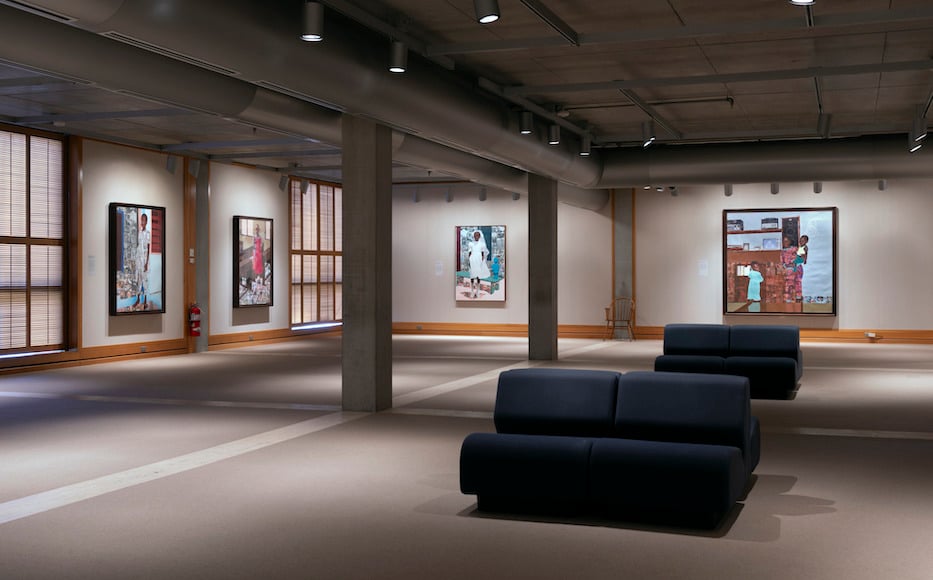
Downtown | Arts & Culture | Yale Center For British Art | University of New Haven

Njideka Akunyili Crosby, YCBA, Richard Caspole Photo.
The Beautyful Ones” Series #8 depicts a young boy standing in a living room, dressed in an oversized blue pastel patterned suit with a hat. Looking past the viewer, he appears calm. He is surrounded with photo collages that appear subtly on his clothing, and more prominently on the floor and furniture behind him. The background mainly consists of a large, dark maroon cabinet that neatly frames the subject, and holds a radio and a VCR.
The image is part of The Hilton Als Series: Njideka Akunyili Crosby, running at the Yale Center for British Art through January 22 of next year. Curated by Hilton Als, the exhibition showcases six pieces from Akunyili Crosby’s ongoing series titled The Beautyful Ones. This series began in 2014, and centers around the theme of childhood.
The Yale Center for British Art is located in downtown New Haven at 1080 Chapel St. Hours and more information are available here.
Born and raised in Enugu, Nigeria, Akunyili Crosby immigrated to the United States when she was 16 years old. Her main subjects are children she has come across in family albums or other photographs. It means that each piece has a unique and nostalgic feeling that shines a different light on common aspects of childhood.
In part, she does that through medium. Her use of acrylic paint, pastels, colored pencils, and photo transfers allows her to tell these experiences through the many layers of her art.

Njideka Akunyili Crosby, YCBA. Richard Caspole Photo.
Walking into the exhibition, the most noticeable aspect is the dark and serene atmosphere: only a few dim lights are scattered throughout the room, and stronger lights are placed on top of the pieces themselves. The calm allows a viewer to feel comfortable in the environment. The curatorial statements greets visitors at the entrance, and to the left is the first piece of the exhibition titled “The Beautyful Ones Are Not Yet Born” Might Not Hold True For Much Longer.
At 83 inches wide and 64 inches tall, this piece meets the viewer at eye level, and welcomes them into its setting. In the work, a young woman sits on a rug that consists of photo transfers, all of them featuring Nigerian women in traditional clothing. The subject herself is wearing a dress patterned with various shades of ultramarine blue, burnt sienna, and white. The subject is facing away from the viewers and is looking at something just out of view.
As the first piece in the series, it welcomes the audience in by reflecting their appearance while looking at the piece. The artist has the subject look in the same direction as the viewer in a relaxed and focused state.
The rest of Akunyili Crosby’s work follows in chronological order in an L shape that eventually leads into the museum’s permanent collection. This arrangement allows viewers to see how the artist progressed and evolved throughout the series. One noticeable development is how the photo transfer placements become more specific and add more conceptual layers to the overall piece.
For example, compared to the first painting, the final piece of the exhibition titled, “The Beautyful Ones” Series #9, has photo transfers placed more thoughtfully throughout the composition.

Njideka Akunyili Crosby, YCBA. Richard Caspole Photo.
This piece makes some of the photo transfers a part of the background by putting a photo in the television and in the picture frames, instead of making it a collage. In general, Akunyili Crosby’s pieces are compact with detail, and displaying them in a dark and quiet room is effective since it eliminates unnecessary distractions and allows the viewer to focus on the artwork in front of them.
Taking inspiration from Ayi Kwei Armah’s 1968 novel The Beautyful Ones Are Not Yet Born, Akunyili Crosby creates politically charged pieces based on modern Nigerian culture. She believed the book lacked hope for Nigeria’s future, since it was written in the midst of the country’s journey to independence. As a response, she paints the new generation of Nigeria and uses old pictures as photo transfers in the background and on the subject’s clothing to contrast the two different time periods.
This technique encourages the audience to make the connection between the photos and the painting itself. The collage of pictures in each piece share a specific theme, and once that theme is found, the viewer may have a better understanding of what the artist is trying to convey. The photographs act like a translator between Nigerian culture and the audience, and guide the viewer’s thoughts in a certain direction.
Although the series as a whole is about the rebirth of Nigeria, this exhibition specifically focuses on issues related to gender roles, maturity, and colonialism. “The Beautyful Ones” Series #4 exemplifies a combination of these themes perfectly. The Nigerian girl wearing a white communion dress symbolizes how the Europeans imposed their religious beliefs onto a non-European country.
The white color of the dress is also a sign of purity and youth. But it's not that simple: the photos on the building and bench behind her, as well as the puddle she stands in, depict older women, and the beauty standards she is expected to live up too. Visually, Akunyili Crosby’s pieces initially appear flat, with a touch that is reminiscent of Cubism. In some pieces, the photo transfers help separate the subject from the background and add some depth. The faces contain the most detail, with their heightened shading and expressions.
The Beautyful Ones is an exhibition made to be experienced in person. Only when face to face with one of Akunyili Crosby’s pieces can these works be fully observed. These large-scale paintings allow for viewers to get lost in the little details that a photograph could likely never capture. From the vibrant colors to authenticity of Nigerian culture, Akunyili Crosby successfully answers the question of who The Beautyful ones are—and how some of them are among us today.
Annalisa Correia is at student at the University of New Haven, where she first wrote this review for Professor Jacquelyn Gleisner. It reappears here with Gleisner's permission.

